Updated 07/14/18
Click here to go straight to the recipe.
Why have I never made these until now? Crunchy, sour, fermented watermelon rind pickles:
- Are easy to make
- Taste delicious
- Contain good microbes, which improve your health
- Cost basically nothing (you bought the melon for the fruit after all)
- Reduce waste
I feel like a character in 1984, the Cookbook. Instead of Big Brother destroying language and meaning so people can no longer express themselves (or protest), Big Food has destroyed our self-reliance and turned us into zombie-consumers heading to the supermarket to fulfill our every need—or even worse, the convenience store for the 26 million Americans living in food deserts.
Of course, I know I don’t speak for everyone. I read the blogs of all you homesteader-types out there, growing heirloom tomatoes from seeds your found at your local seed library, transforming your yards to duck paradises or curing hams from pigs you raised yourself. But I think I can safely say that the majority of us eating the Western (sadly, now global) diet have lost a lot of knowledge about food—where it comes from, how to grow it and how to prepare it. We need to bring back home-ec in every public school, for boys and girls (hey, it could happen!).
Ingredients
- Rind from a watermelon
- 1 tablespoon kosher or sea salt (avoid table salt as it is devoid of the minerals lacto bacteria love)
- 4 cups filtered tap water (let it sit for at least a few hours to dissipate the chlorine if your municipal tap water is highly chlorinated)
- Whey (optional)
- Mustard seed, dill seed and/or caraway seed (optional)
I highly recommend adding fresh dill and several cloves of garlic to these.
Directions
I tried cutting the watermelon a couple of different ways. Working with a large chunk of melon takes less time than than working with little slices of rind.
However, I always cut up my watermelons as in the above picture. If you have watermelon rinds on your hands, they will probably have started out as slices. Either way works.
1. Cut the fruit from the rind. Eat. Peel the dark green skin from the watermelon rinds. Cut the rinds into 1-inch squares.
2. If you’re adding fresh dill and garlic and other spices, place them in the bottom of a large jar.
3. Place the rinds, salt and water in the jar. You want the water to cover the watermelon rinds by an inch or two. For every four cups of water, add a tablespoons of kosher salt. You may need less water. My rinds were pretty thin and small so four cups was a bit too much.
The vegetables have enough microbes on them to ferment spontaneously but if you want to kickstart your ferment, toss in some whey. I grew impatient after a few days with my ferment’s slow progress (probably due to too much water), so I poured in a tablespoon or so. If you make yogurt to avoid plastic, or you buy cultured yogurt, strain a little through a cheesecloth-lined coffee filter to render whey.
4. These rinds float directly to the top of the water. When you ferment food, to prevent mold from growing, completely submerge the vegetables in the salty water. If mold does grow, simply scrape it off and compost the top layer of vegetables. Your ferment will be fine. Bad microbes cannot live in the acidic environment of a lacto-bacteria (LAB) culture. And you need not worry about botulism. That only occasionally happens as a result of improper canning, the antithesis of fermentation. Botulism spores cannot survive in a LAB culture. (Go to Sandor Katz’s website for more info.)
So, I made a neat little tight-fitting makeshift “cap” from the end of the watermelon, scooped out the flesh, halved it and stuffed it into the jar to keep the rinds submerged. (I felt like a brain surgeon.) I removed the heavy lid from another glass jar and placed it on the watermelon cap to keep everything weighed down. Then I put a jar on top of this so it wouldn’t shift.
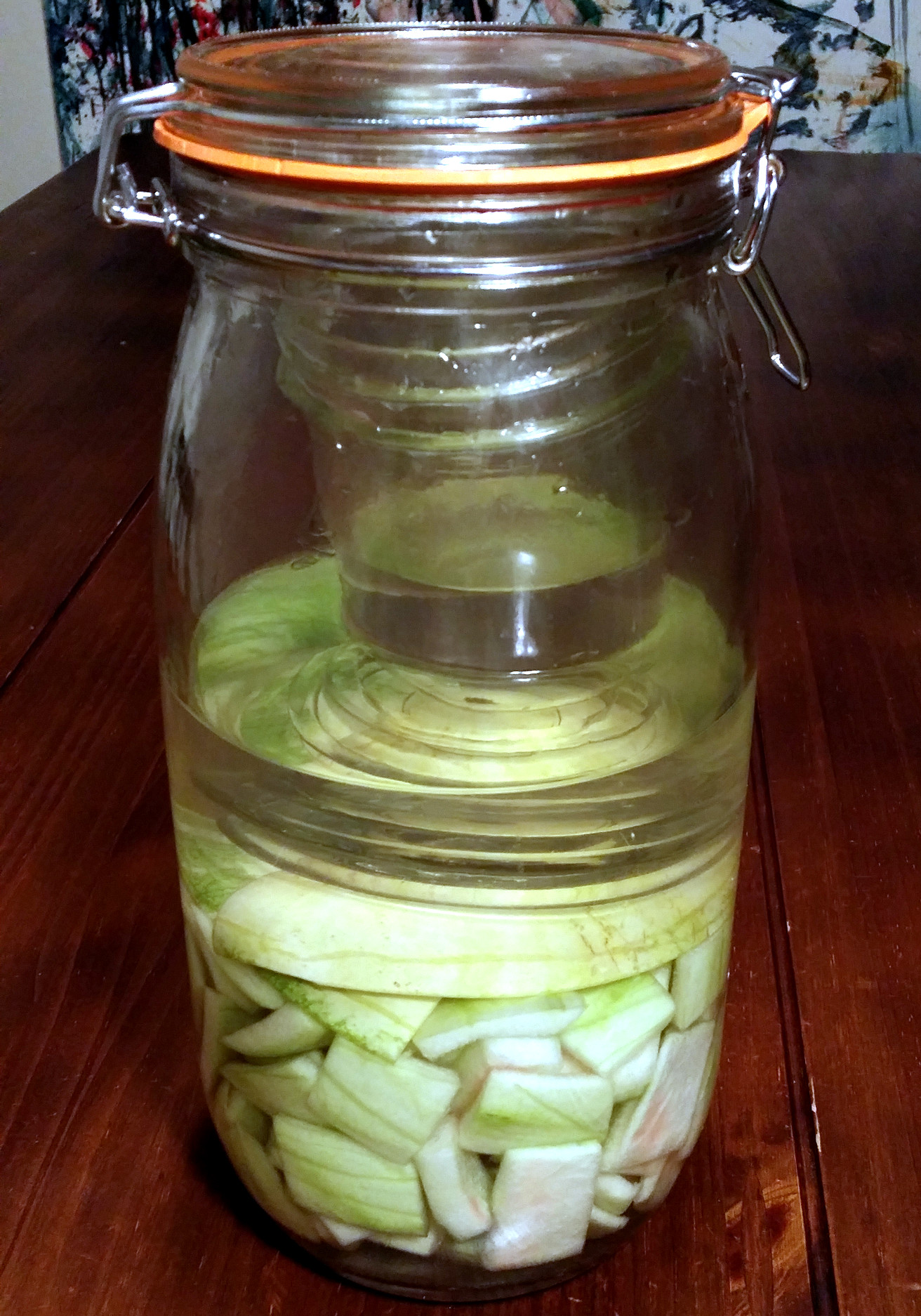
5. Set your jar aside in a cool spot for a few days. You may have to burp it, which means opening the lid daily to allow built-up carbon dioxide to escape (and thus avoid a possible explosion). You’ll automatically do this when you taste the rinds daily. Once they have pickled to your liking, move the jar into the refrigerator to retard the fermentation. You may like them after one day. I prefer my ferments quite sour. I let these sit for five days and they taste pretty yummy.
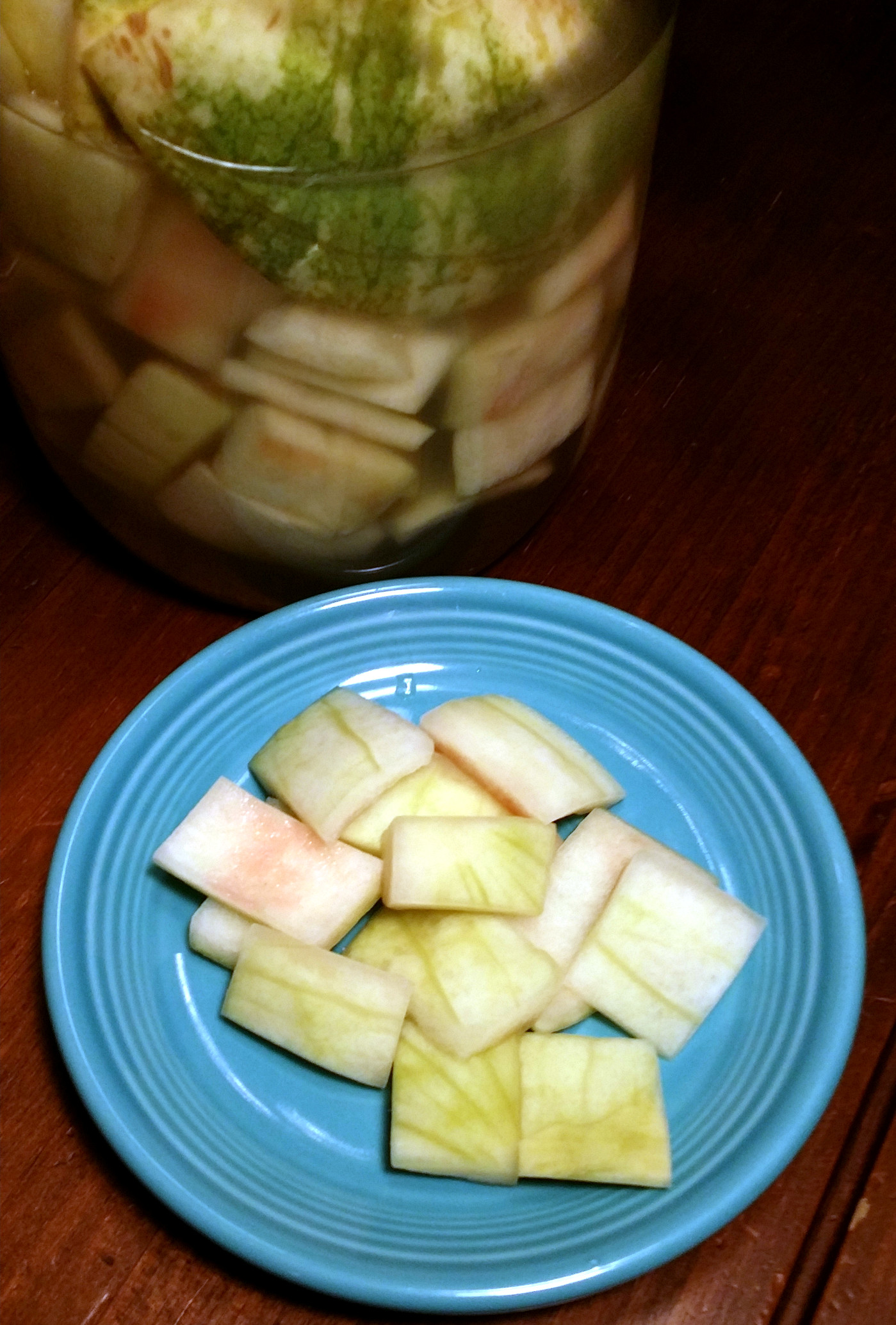
Fermented Watermelon Rind Pickles
Ingredients
- Rind from 1 watermelon
- 1 tablespoon kosher or sea salt
- 4 cups filtered tap water
- 2 tablespoons whey (optional)
- Mustard seed, dill seed and/or caraway seed (optional)
I highly recommend adding fresh dill and several cloves of garlic to these.
Directions
1. Peel the dark green skin from the watermelon rinds. Cut the rinds into 1-inch squares.
2. If you’re adding fresh dill and garlic and other spices, place them in the bottom of a large jar.
3. Place rinds, salt, water and, if using, whey in the jar. Weigh down the vegetables with a large piece of watermelon rind, a leaf of cabbage, a glass weight or whatever else you have on hand.
4. Set your jar aside in a cool spot for a few days. Open the lid daily to allow built-up air to escape.
5. Taste the rinds daily. When they have pickled to your liking, move the jar into the refrigerator to retard the fermentation. This may take as little as a day or as long as a week, depending on your taste preference.


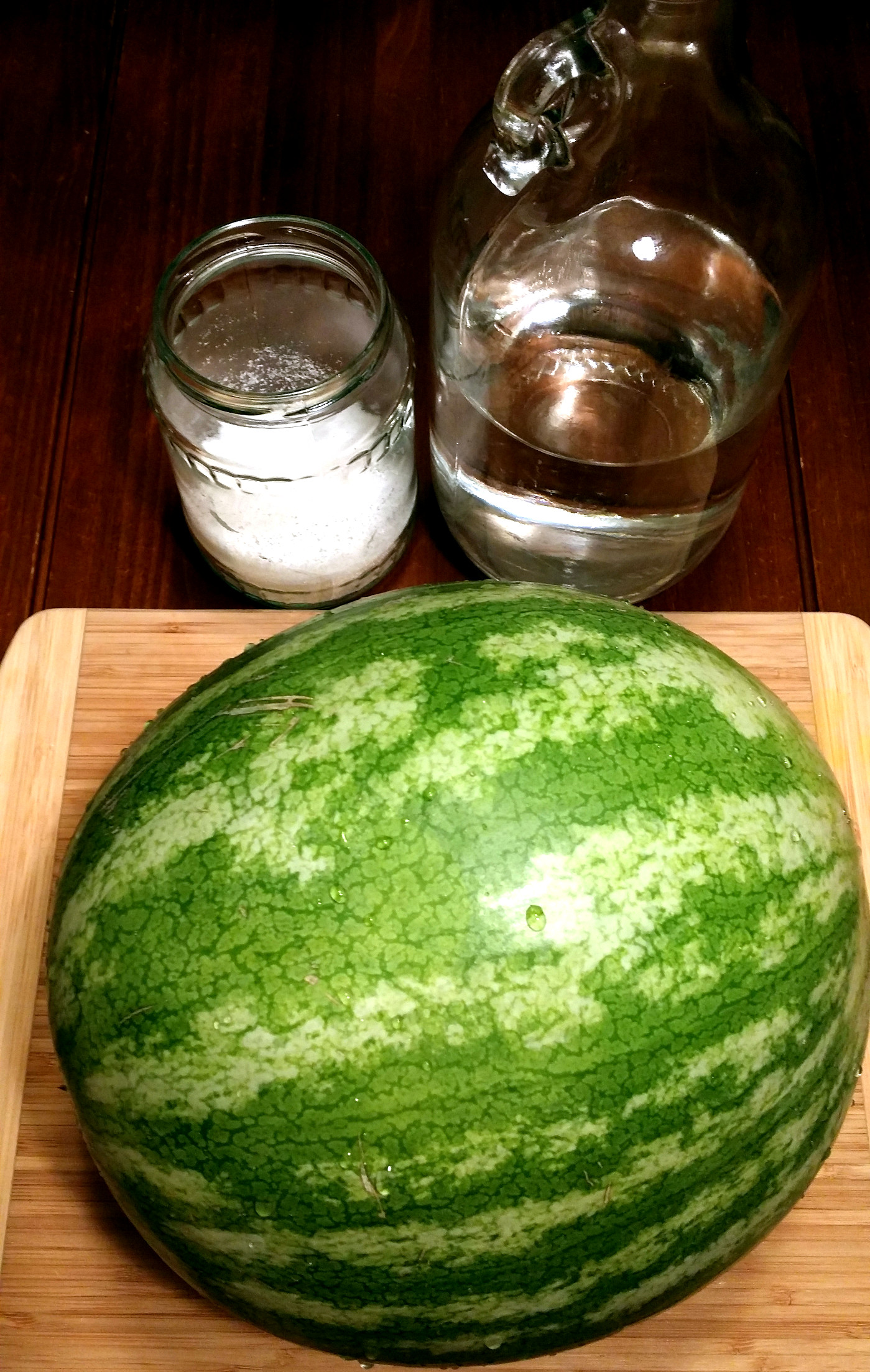
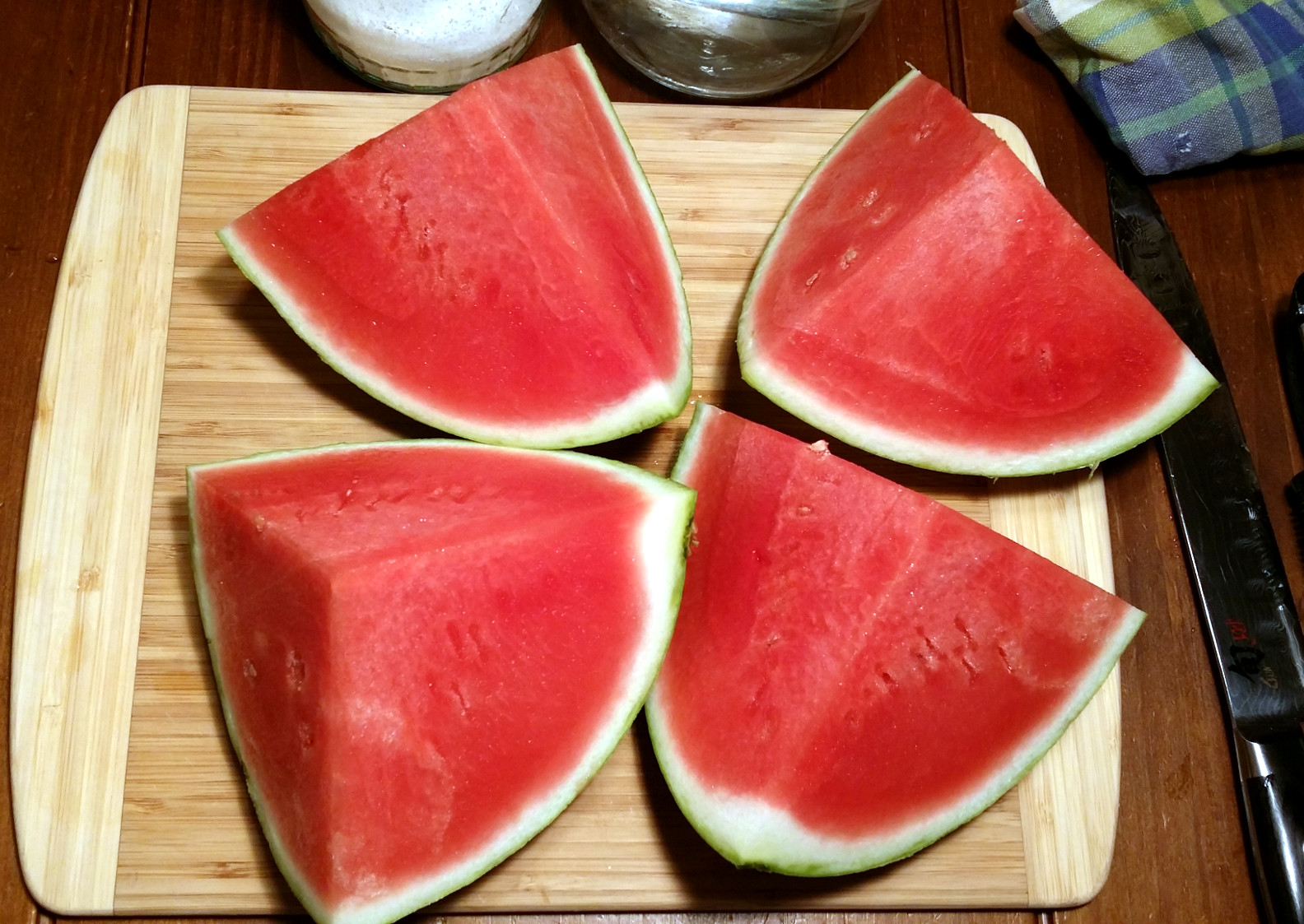
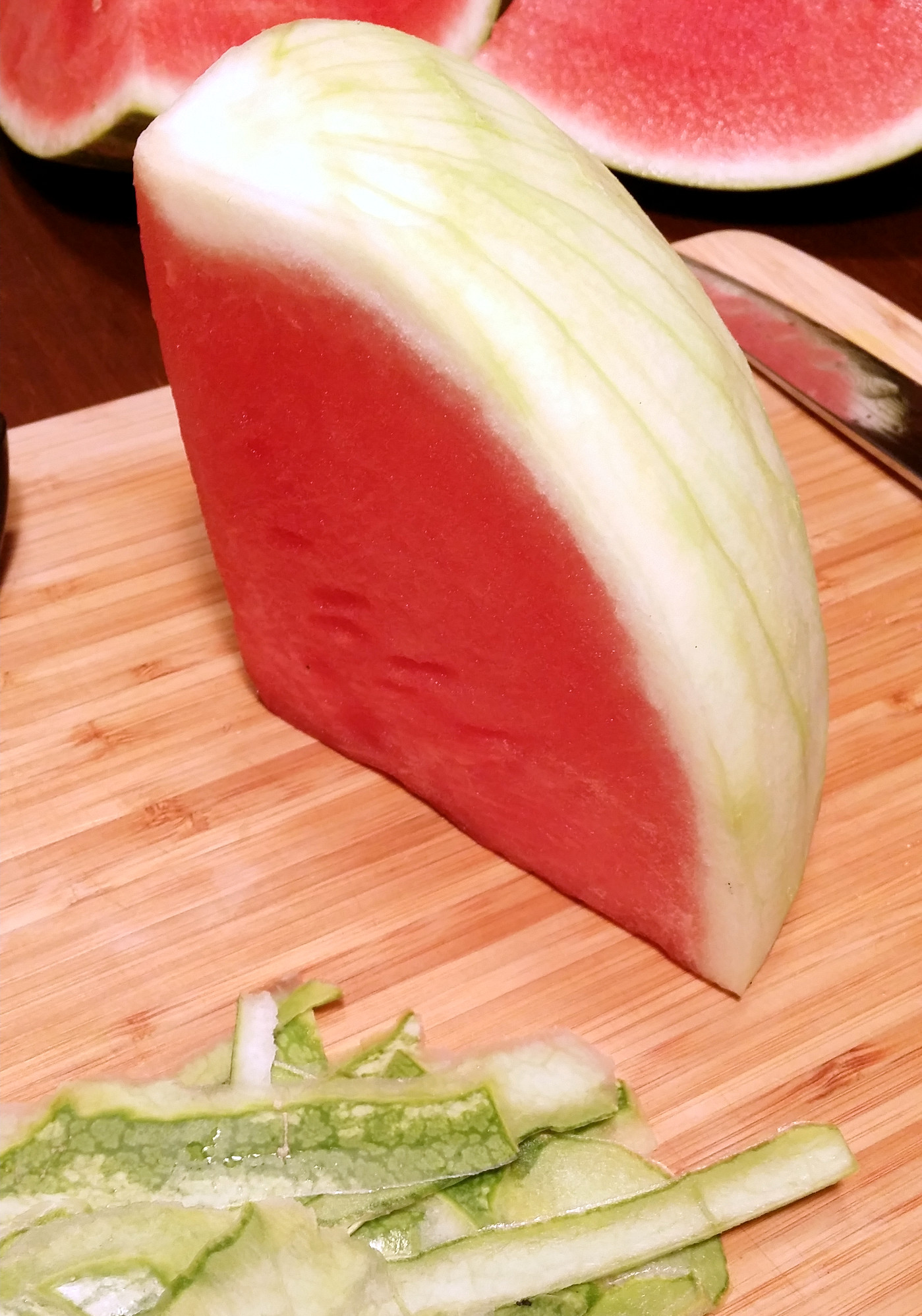
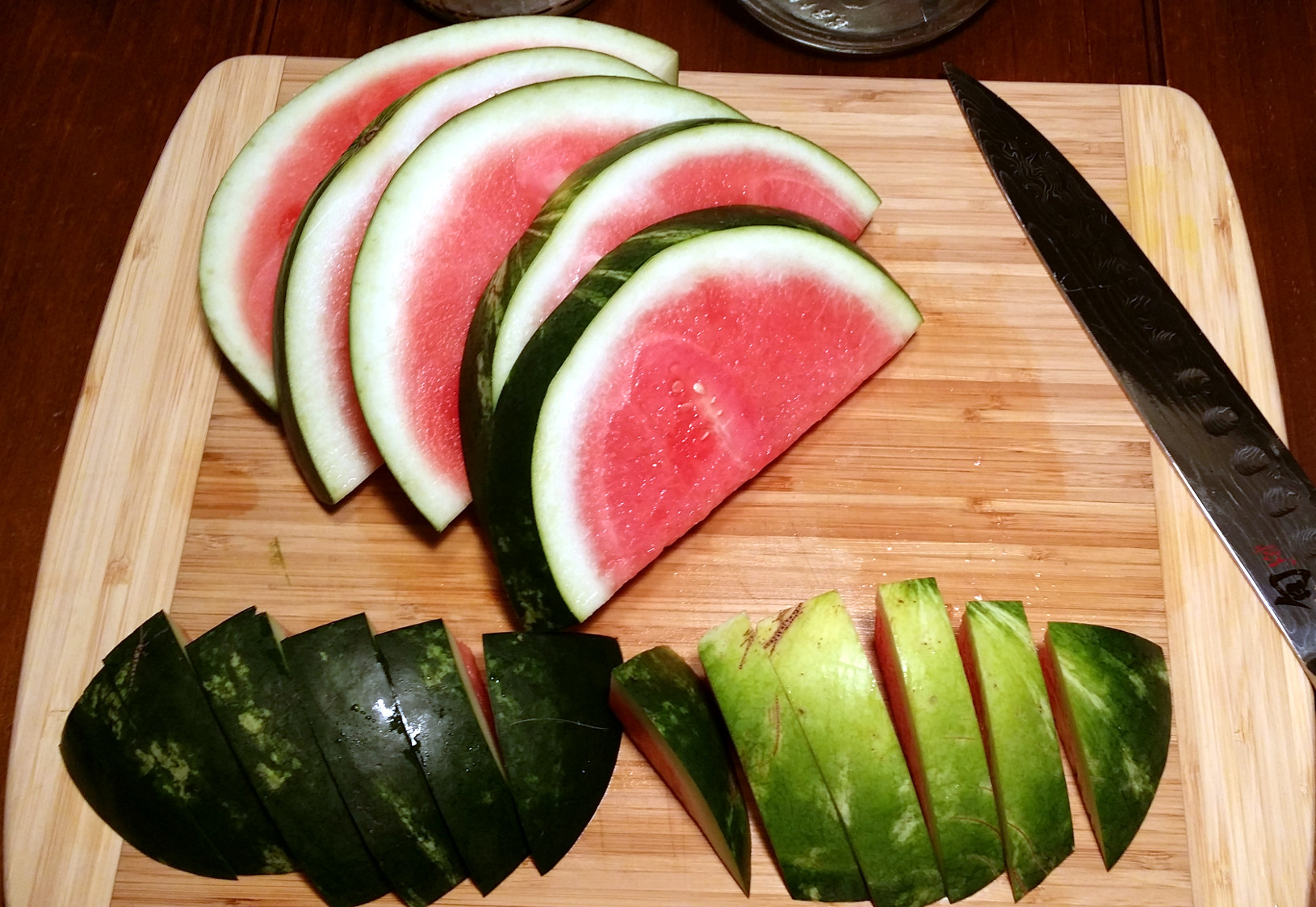


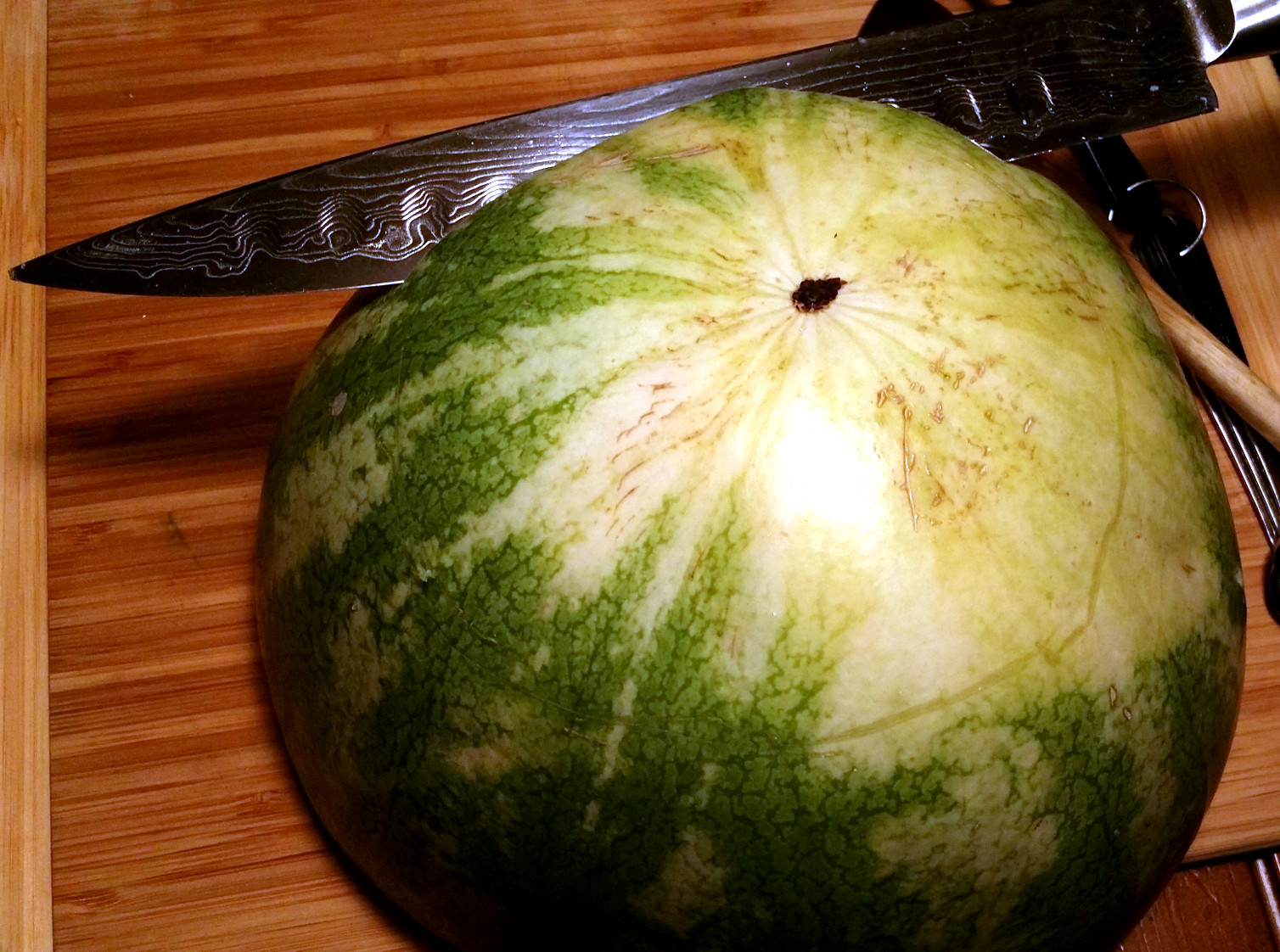

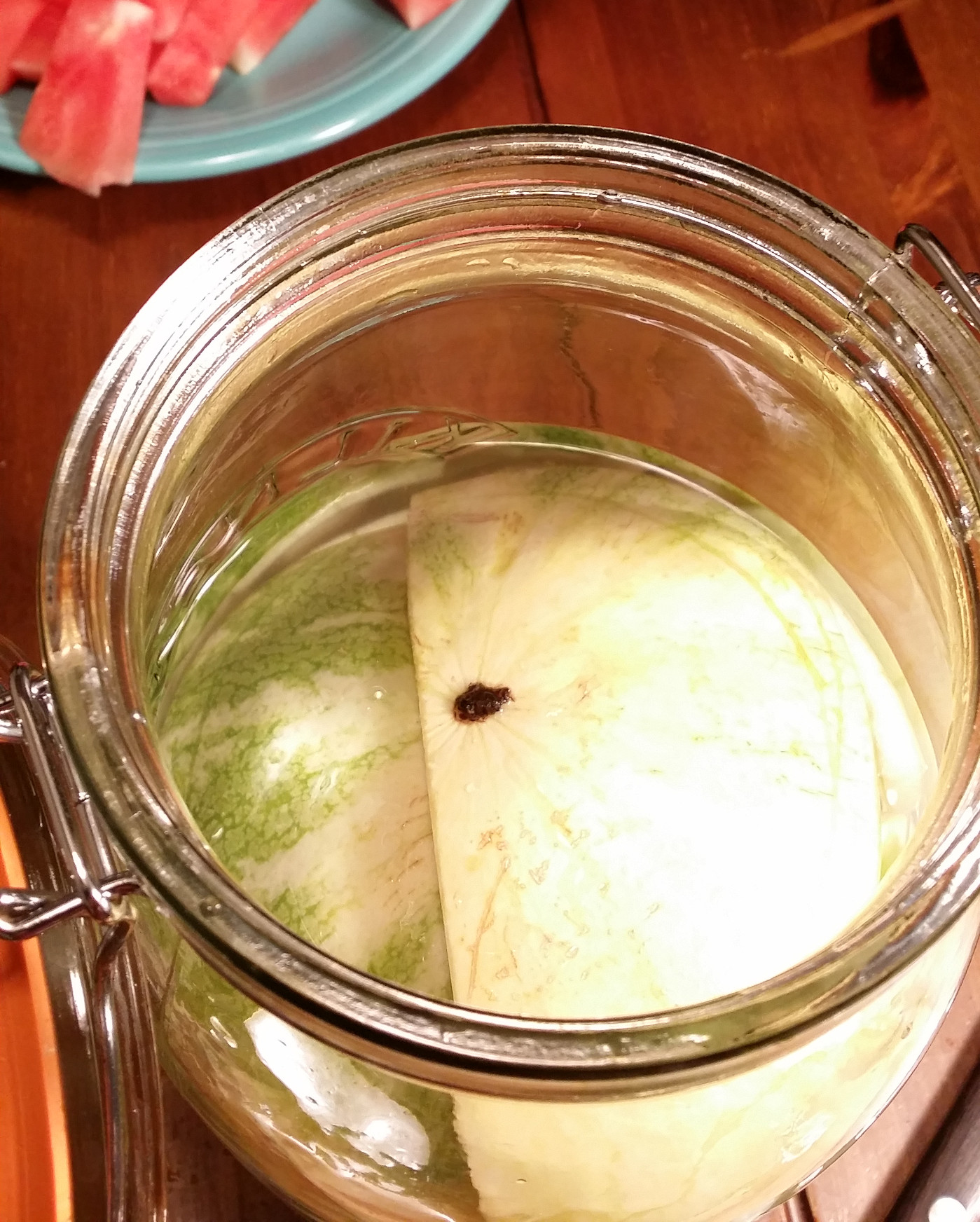
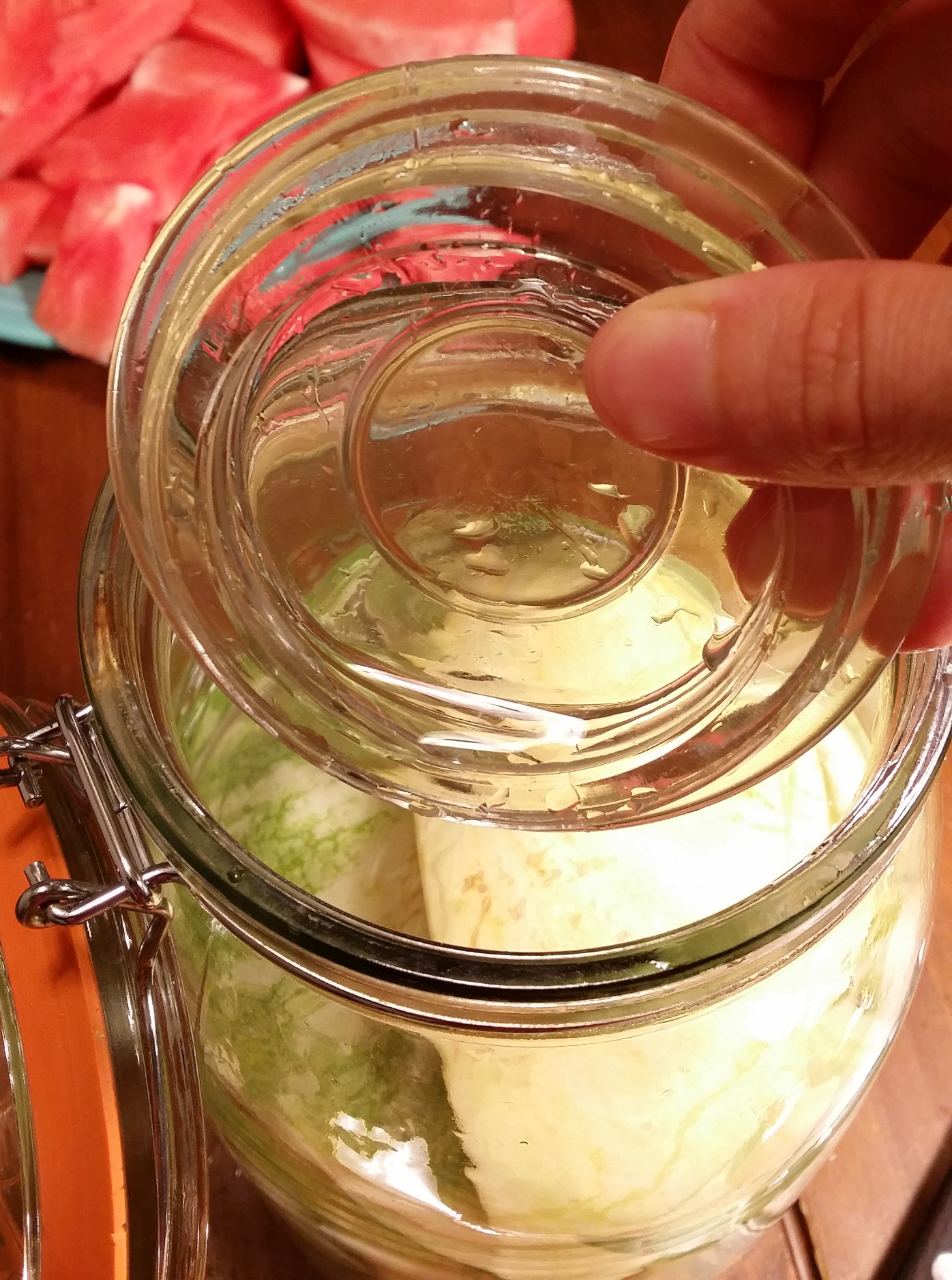
Wow! The things you do with what most people would consider waste is amazing and inspirational. I agree that our diet is so limited and so “samey”…its the same in New Zealand. But every little bit helps I guess and if it were summertime here I would be running out to get some watermelon. As it is this cold rainy evening is not conducive to thoughts of said fruit!!! Thanks so much for your post…thet are always interesting and often surprising! Andi
Thank you Andi 🙂 I’m trying to think of more things to make out of “trash.” That unhealthy “samey” diet has spread all over. But things are changing (as you know, as a livestock-raising homesteader type), which gives me hope.
Very cool, can you use any kind of melon? Honeydew? Is supermarket ok as a melon source? Not growing my own this year.
Hmmm, that’s a really good question. I did a search and found something for pickled honeydew rinds, but they aren’t fermented. You have to heat up water, dissolve a bunch of sugar, strain stuff…I’m sure they would be good, but I love the simplicity of fermentation (throw stuff in jar and wait). I don’t see why thick rinds like honeydew wouldn’t work. I’ll have to try it. Please let me know if you do…
The supermarket should be just fine. I would stick to organic though. I doubt watermelons are irradiated (but you never know!). I’ve read than irradiation may kill the microbes that live on produce, thus obstructing the fermentation.
Thanks I’ll let you know. We did pickle cucumbers using sea salt in a similar way last year. I liked the more subtle taste without the vinegar.
Thank you! I love the flavor too.
Interesting. I’m learning a lot from you! 🙂 Thanks!
You’re welcome! I’m learning a lot blogging. Thanks for the comment 🙂
I never thought of that; great idea!
I read about it in one of Sandor Katz’s books and was surprised that you can turn the rind into a tasty snack. I had no idea.
Interesting. I do a sweet pickle with watermelon rinds every year, but I’ve never fermented them. I will definitely try that with the next watermelon I get.
Yum! That sounds good. I want to come eat at your house. Do you have that recipe posted on your blog by any chance?
Yep! I do believe it’s one of my most popular posts of all time. Look on the recipe page, under pickles.
Great! I’ll do that. Thank you 🙂
I have not fermented one item that wasn’t improved by the process. I look forward to trying this one once I find some organic melons in this part of the world.
I agree. Fermentation is like magic (well, actually, it’s science, but I find it fascinating). It makes everything taste great, improves the nutritional value, preserves food without consuming energy…I could go on and on (to which my children can attest!). I hope you enjoy the pickles when summer returns to your part of the world.
I wanna makes these 😀 I once had a recipe call for pickled watermelon rinds and I was so confused!
Also, what would one use these for? Put them on sandwiches? Eat then straight?
I ate the ones in the pic straight. I think you could use them in any recipe that calls for pickles (dill, not sweet). I try to eat some fermented food every day as a garnish with my meals (I love sauerkraut with scrambled eggs). It’s so good for you and so easy to make. Let me know how yours turn out 🙂
I love everything you are about. I hope you don’t mind, I nominated you for the “Very Inspiring Blogger Award.” Thoroughly enjoying following you 🙂
http://savingsgraceblog.com/2014/07/19/very-inspiring-blogger-award/
Thank you so much! I really appreciate it. I’m glad you’re enjoying my blog 🙂
Thanks for the tips on how to keep everything submerged – very helpful 🙂
You’re welcome! I made some more beet kvass last week and I covered everything with a large piece of radicchio. Then I put a small ceramic dish over that. So far, so good. A cabbage leaf should work too. Sandor Katz says he doesn’t mind mold growing on the top of his fermented vegetables. He just scrapes it off. But I have a difficult enough time convincing my family to eat anything fermented. If they see mold, forget it, even though the food underneath is safe to eat.
First of all, thanks for the shout-out!!! (We have been dealing with some intense stuff this summer so I apologize that I did not get to read it and thank you sooner…) Secondly, where the ducks do you buy whey? I have tried the usual sources around here (Whole Foods, natural foods places) but they have the nutritional supplement stuff not the kind used for fermenting. Do you buy it online? Thirdly, pickles rock!!! Thx for sharing the recipe!!! 🙂
You’re welcome! I love reading your posts 🙂 I hope the intense stuff calms down and everything is okay with you.
I’m not sure where to buy whey. When I make yogurt, I strain some and that’s how I get mine. You can use store-bought cultured yogurt too. Just plop some into a cloth-lined sieve or coffee filter and set that over a bowl or glass. Then wait while the whey drips out. As you know, Sally Fallon says just add a bit of extra salt and ferments will start without whey. I don’t add it to my sauerkraut and that ferments very well. But I was impatient with these pickles, so I threw some in (I have given myself a Wednesday deadline for my posts and worried I wouldn’t hit it!). I hope that helps!
It does! Thanks!!!
You’re welcome 🙂
Sounds really interesting… It just shows how creative thinking about food can result in something deliciousfor almost no cost!
They are pretty tasty. I had a few at lunch. I’m trying to think up other things I can make from something considered trash/compost. Thank you for the comment 🙂
[…] http://zerowastechef.com/2014/07/16/fermented-watermelon-rind-pickles/ […]
[…] Fermented watermelon rind pickles, once again by @Zero Waste Chef; and […]
So, how it’s turned out? 🙂 My parents make preserved watermelon slices, they are a bit salty, and to be honest I’m not fan of them 😀
Well I like my ferments stronger and more sour than most people. I let the rinds in this post ferment for about a week (as I recall), so they taste quite strong, and I’m the only one who will eat them (I have a few left–fermented food can keep for years in the fridge, anther benefit). I made another batch last weekend and let them ferment for a shorter period of time, plus I added less salt. The salt speeds up the fermentation. So these new pickled rinds aren’t nearly as sour. But with less salt, they are less crunchy too! So I may get complaints about that. Not that I mind eating them all, but fermented food is so good for you. I wish my daughter would eat it.
I would love to try fermenting watermelon slices. I have made preserved lemons, but not other fruit. I mostly do vegetables and sourdough. Thanks for the comment 🙂
I’ve finally got some of these into a jar. My first food ferment… fingers crossed!
That’s so exciting. Just make sure everything stays submerged under water and they should turn out well. Thanks for letting me know you tried them out 🙂
I just tasted these for the first time today, so 3 and a bit days. They’ve been fermenting happily, and thanks to your tips they’ve kept submerged (watermelon skin, extra jar lid filled with water and vacuvin stopper for that last bit of height!). I really don’t know how to describe the taste, it’s really complex. A bit sour, a bit salty, a bit sweet… to be honest, I can’t decide whether I like it or not!! I didn’t add any extra spices as I didn’t have any to hand. I think I’ll let them go another day then refrigerate. Have you ever added spices after you’ve finished the fermentation?
I think adding spices after should be fine. I flavor my kombucha after the initial ferment with candied ginger. I haven’t tried flavoring after fermenting a vegetable but don’t see why it wouldn’t work. I hope you like the flavor better if you do that. Thanks for keeping me posted 🙂
[…] rinds: Watermelon rinds can be pickled and eaten. They are a tasty treat, click here to see how to pickle […]
[…] Of course, I know I don’t speak for everyone. I read the blogs of all you homesteader-types out there, growing heirloom tomatoes from seeds your found at your local seed library, transforming your yards to duck paradises or curing hams from pigs you raised yourself. But I think I can safely say that the majority of us eating the Western (sadly, now global) diet have lost a lot of knowledge about food—where it comes from, how to grow it and how to prepare it. We need to bring back home-ec in every public school, for boys and girls (hey, it could happen!). READ MORE… […]
[…] Of course, I know I don’t speak for everyone. I read the blogs of all you homesteader-types out there, growing heirloom tomatoes from seeds your found at your local seed library, transforming your yards to duck paradises or curing hams from pigs you raised yourself. But I think I can safely say that the majority of us eating the Western (sadly, now global) diet have lost a lot of knowledge about food—where it comes from, how to grow it and how to prepare it. We need to bring back home-ec in every public school, for boys and girls (hey, it could happen!). READ MORE… […]
I just found your website and I’m bookmarking it to explore when I have more time. I’m so excited! We were at a friend’s house the other day and noticed he had a couple watermelons left in his garden. He gave us one and it was SUPERB… an heirloom pink! He said he already has enough seeds saved up for next year so we are saving ours for our own watermelon patch! 🙂 After thoroughly enjoying our watermelon and saving the seeds, we did throw away the rinds this year. But, I have plans for next year… My grandma made watermelon pickles and I loved them! I don’t think I have her recipe so I went searching the internet and found your gem! The pickles Grandma made were sweet but I am eating much healthier now so I’m going to try your version first before I resort to sweet pickles! We have recently begun fermenting – Kefir, Kombucha, Sauerkraut, Sourdough. I’m loving it! 🙂 Thanks for sharing!
Thanks so much Susie. I’m excited you found my site too 🙂 I want to update this recipe. I think these would taste great with tons of fresh dill and garlic shoved into the jar. I love fermenting too. It’s so much fun. Enjoy! ~ Anne Marie
Where can you purchase sour watermelon pickles, I understand this will bring back taste buds?
Have a friend that lost his from Chemo treatments.
Many thanks,
Ken
———–
Hi Ken, I’m sorry about your friend. I have never seen these in a store. I think your best bet is a farmer’s market and even then, it would be tricky. I had never heard that chemo patients might be able to taste fermented foods. Does your friend like kimchi? That’s potent and delicious stuff. You can find that in the refrigerator section at some health food stores and some Whole Foods. I hope it works for your friend. ~ Anne Marie
Finally made these with some homegrown watermelons and – wow, they are so delicious! I seasoned them with some garlic and mustard seeds. Thanks for the great recipe!
:O Homegrown is the best! I’m so happy to hear you like them. Thanks for letting me know. Enjoy!
How long do these last in the fridge?
These will last for months. They’ll continue to ferment slowly and eventually lose their crunch but not for a while.
Just found your site! I have some watermelon rind in a brine in the fridge. Can I make traditional pickles (such as your recipe) above, being that my rind came out of the fridge? (Because they have to sit on the counter?Would they go mushy?) Had no idea (nor never tried pickled watermelon rind) that ALL of the recipes are for sweet tasting not traditional kosher style. Would love to try these! Thanks again!
I am vegan and wonder if you think I could use the whey from a batch of homemade soy milk yogurt in place of the dairy whey?
Hi Terry,
This will still ferment without the whey. It might take an extra day. Whey kickstarts the ferment and innoculates it against bad bacteria but I made my last batch without the whey. It worked well.
Anne Marie
Hello! I love your blog and all your ideas. I’m also a lacto- maniac!!!! I just did a batch of watermelon rinds but I left the skin. I’m thinking they might remain firmer and then we can choose not to eat the skin or eat it if it’s good. Ha ebyiu ever tried with the skin?
Thank you for spreading the knowledge about being zero waste and lactofermentation which goes hand in hand.
Oooh, that’s a good idea Séverine. I will try that. Like pickles, these can go soft if you don’t keep an eye on them. Nice to meet a fellow fanatic 😀 I too think they go hand in hand. When you reduce your waste, you pick up some useful skills and this is one of them. ~ Anne Marie
Hi Anne Marie! I’m late to the game but decided to try these fermented watermelon rinds 🙂 I’ve made sauerkraut a few times following your instructions and I love it! However, I’m on day 3 with the watermelon and I gotta be honest, it tastes disgusting! Really, really bitter. Is that normal? I’ve never had fermented watermelon rinds before so perhaps it’s just not a taste I like, but I feel like I’ve done something wrong even though your recipe couldn’t be simpler to follow. Thoughts or ideas? I’m going to keep em going and keep trying them so we’ll see if the taste improves for me
Thanks for sharing. I’ve wanted to try out watermelon rind this way for a while. Pumpkin rind + skin is great if you boil it a little first before pickling and add cinnamon quills and star anise.
Wow! Thank you for the idea Margaret. I have to try that!
~ Anne-Marie
You’re welcome Anne-Marie! Here’s the recipe I usually use: https://www.delicious.com.au/recipes/pickled-pumpkin-rind/f869bdd8-89f2-4f6e-8528-e46d60603da2
How should the watermelon rind taste after fermenting it for 3-4 days? Mine is very soft and not crunchy at all, not sour and taste a hint of alcohol. How to keep the rind crunchy?
Hi Yen,
It sounds as though they fermented if they taste slightly alcoholic. If they aren’t crunchy, you can’t bring them back. You could add some grape leaves or black tea to the jar if you try again. They should taste sour if they are fermenting so I’m not sure why they aren’t sour. Was there much fruit left on the rind? That might account for the alcohol taste. Did you see any bubbling in the jar?
~ Anne-Marie
If I left a bit of pink fruit on the rind will this mess up the batch? Just start tonight and there’s a bit of pink left on my cubes.
I have not yet lacto-fermented watermelon rinds (soon soon…) but sweet and sour (vinegar – basically bread and butter-) pickled watermelon rinds were a staple of my childhood. My Dad made the pickles (my Mom made the jam) and we used to have serious watermelon eating sessions, as well as preciously saving all rinds in the rind bucket and not the compost, to provide him with the rinds he needed. These he would brine overnight and then cook up with vinegar, sugar and spices. That was the “good old days” when watermelons came with a rind you could sink your teeth into. I still make them, 50 years later, but I am SO DISAPPOINTED by the rinds on the watermelons of today… Maybe in North America you can still get a proper watermelon with a 1.5 inch rind. Your pictures, Anne-Marie, look like rinds that deserve the name, but nothing measures up to the rinds of my childhood :-)). Here in Europe the white part of the rind is becoming vanishingly thin. And nobody seems to know how to source seeds for the old-fashioned varieties. So I understand Heather A.’s problem because if you take away the green and you take away all the pink often there is not much left…